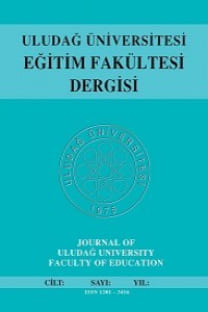Öğretim Elemanlarının Atwood Aleti Problemi Çözüm Stratejilerinin Prakseolojik Analizi
Bu araştırmanın amacı, Newton Mekaniğinin alışılmış ve evrensel problemlerinden biri olan Atwood Aleti problemine ilişkin öğretim elemanlarının çözüm stratejilerini ve tutarlılıklarını analiz etmektir. Araştırmada kullanılan veriler İngilizce başta olmak üzere çeşitli dillerde internet üzerinde yayınlanmış 30 öğretim elemanının çözümleridir. Çözümler nitel olarak Prakseolojik Analiz yöntemiyle analiz edilmiştir. Araştırma sonucunda, üç farklı çözüm stratejisi tespit edilmiştir. Atwood Aleti probleminin doğasındaki zorluktan kaynaklanan çözümü basitleştirme eğilimi çözümlerdeki bazı güçlükleri ve iç tutarsızlıkları ortaya çıkarmıştır. Öğretim elemanlarının izledikleri problem çözüm stratejilerinin değişik basamaklarında tutarlı olmadıkları gözlenmiştir. Bu stratejilerin, öğrencilerin anlamlı ve tutarlı bir problem çözme stratejisi geliştirmesine izin vermeyen nitelikte olduğu sonucuna varılmıştır. Bu araştırmanın sonuçları tartışılmış ve anlamlı bir çözüm için farklı stratejiler önerilmiştir
Anahtar Kelimeler:
Atwood Aleti Problemi, Problem Çözme Stratejileri, Öğretim Elemanı Çözümleri, Anlamlı Öğrenme, Prakseolojik Analiz
Öğretim Elemanlarının Atwood Aleti Problemi Çözüm Stratejilerinin Prakseolojik Analizi
Keywords:
-,
___
- Bosch, M., Chevallard, Y., & Gascon, J. (2005). Science or magic? The use of models and theories in didactics of mathematics. In Proceedings of the Fourth Congress of the European Society for Research in Mathematics Education. http://ermeweb.free.fr/CERME4/CERME4_WG11.pdf 12.03.2009 tarihinde erişilmiştir.
- Chevallard, Y. (1997). Familière et problématique, la figure du professeur. Recherches en Didactique des Mathématiques, 17(3), 17-54.
- Chevallard, Y. (1998). Analyse des pratiques enseignantes et didactique des mathématiques: L’approche anthropologique. La Rochelle-France. http://yves.chevallard.free.fr/spip/spip/IMG/pdf/Analyse_des_pratiques_e nseignantes.pdf 12.03.2009 tarihinde erişilmiştir.
- Chi, M., Feltovich, P., & Glaser, R. (1981). Categorization and representation of physics problems by experts and novices. Cognitive Science, 5(2), 121- 152.
- Çalışkan, S., Selçuk, G. S., & Erol, M. (2006). Fizik öğretmen adaylarının problem çözme davranışlarının değerlendirilmesi. H.Ü. Eğitim Fakültesi Dergisi, (30), 73–81.
- Dhillon, A. (1998). Individual differences within problem-solving strategies used in physics. Science Education, 82, 379-405.
- Dumas-Carré, A., & Goffard, M. (1997). Rénover les activités de résolution de problémes en physique. Paris: Armand Colin/Masson.
- Fabre, M. (1999). Situations-Problèmes et savoir scolaire. Paris: Presse Universitaire de France (PUF).
- Gaidioz, P., Vince, J., & Thiberghien, A. (2004). Aider l'élève à comprendre le fonctionnement de la physique et son articulation avec la vie quotidienne. BUP, 866, 1029-1042.
- Gick, M. L. (1986). Problem-Solving Strategies. Educational Psychologist, 21(1&2), 99-120.
- Heller, P., Keith, R., & S.Anderson. (1992). Teaching problem solving through cooperative grouping. Part 1.Group versus individual problem solving. Am. J. Phys., 60, 627-636.
- Heuvelen, A. V. (1991). Learning to think like a physicist: A review of research- based instructionalstrategies. Am. J. Phys., 59, 891-897.
- Johsua, S., & Dupin, J. (1999). Introduction à la didactique des sciences et des mathématiques. Paris: Presse Universitaire de France (PUF).
- Leonard, W., Dufresne, R., & Mestre, J. (1996). Using qualitative problem-solving strategies to highlight the role of conceptual knowledge in solving problems. Am. J. Phys., 64, 1495-150.
- McDermott, L. C., Shaffer, P. S., & Somers, M. D. (1994). Research as a guide for teaching introductory mechanics: An illustration in the context of the Atwood's machine. Am. J. Phys., 62(1), 46-55.
- Newell, A., & Simon, H. (1972). Human Problem Solving (Englewood Cliffs.). NJ: Prentice Hall.
- Özsoy, G. (2005). Problem Çözme Becerisi İle Matematik Başarısı Arasındaki İlişki. GÜ, Gazi Eğitim Fakültesi Dergisi, 25(3), 179-190.
- Reif, F. (1983). Understanding and teaching problem-solving in physics. In Research on Physics Education: Proceedings of the First International Workshop, June 26-July 13, 1983. La Londe les Maures.
- Reif, F. (1995). Millikan Lecture 1994: Understanding and teaching important scientific thought processes. Am. J. Phys., 63, 17-32.
- Reif, F., Larkin, H., & Brackett, G. (1976). Teaching general learning and problem- solving skills. Am. J. Phys., 44-3, 212-217.
- Serway, A., & Robert, J. (2002). Fen ve mühendislik için fizik- 1 (5th ed.). Ankara: Palme Yayıncılık.
- VanLehn, K. (1996). Conceptual and meta learning during coached problem solving. In Proceedings of the 3rd International Conference on IntelligentTutoring Systems ITS '96.
- Yavuz, A. (2007). Stratégie de résolution d'exercice en mécanique du point matériel. Stratégie des enseignants et difficultés des étudiants de la première année universitaire: Exemple du problème de la machine d'Atwood. Yayınlanmamış Doktora Tezi, Université Jospeh Fourier Grenoble 1 France.
- Başlangıç: 1986
- Yayıncı: Bursa Uludağ Üniversitesi Eğitim Fakültesi
Sayıdaki Diğer Makaleler
Hakan Şevki AYVACI, Çiğdem ŞAHİN
Fen Öğretmen Adaylarının Yapılandırmacı Yaklaşıma Yönelik Tutumlarının İncelenmesi
Ertuğ EVREKLİ, Didem İNEL, Ali Günay BALIM, Teoman KESERCİOĞLU
İlköğretim 6. Sınıf Türkçe Kitaplarındaki Kelime Grupları ve Öğretimi Üzerine Bir Değerlendirme
Süleyman EROĞLU, Nilay ÇAĞLAYAN
Ferruh AŞÇI, Ahmet BURSALI, Muhlis ÖZKAN
Ali Canip Yöntem'in Eğitim ve Edebiyat Eğitimi Hakkındaki Düşünceleri
Biyoloji Öğretmen Adaylarının Biyoloji Öğretimine Yönelik Öz-Yeterlik İnançları
Yasemin HARURLUOĞLU, Ercan KAYA
Semantic Relations in The Comparative Phraseological Units in English and Bulgarian
Kontrbas Eğitiminde Çağdaş Türk Müziği Eserlerinin Yeri ve Değerlendirilmesi
